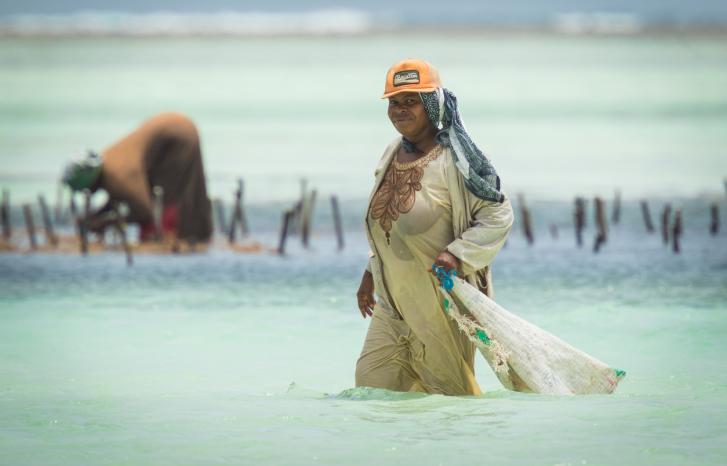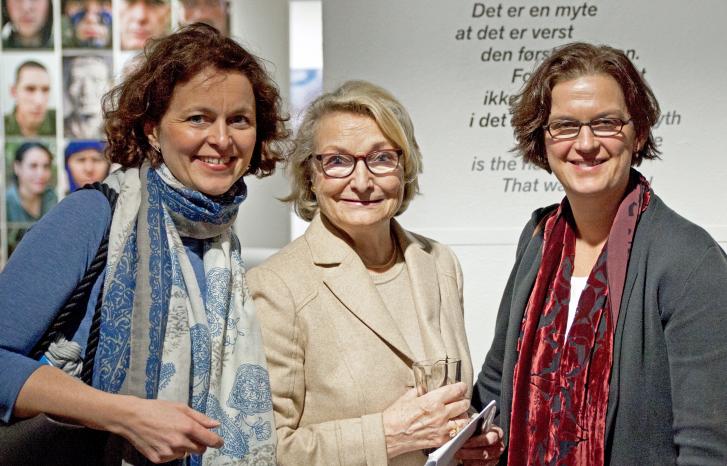On the countryside of Uttar Pradesh, India, agriculture and animal husbandry is the livelihood for most of the population. The small villages are isolated, and from 2009, they had access to electricity through micro solar power stations. Men from the villages have been taught how to maintain the solar panels, whereas external engineers take care of repairs. With solar energy, the villages have electric light and electricity for fans, TVs, and mobile phones. In one of the villages, the access to electricity has even provided the inhabitants with water mains.
The mountain area Bamiyan is one of four provinces in Afghanistan in which the Norwegian Church Aid has provided solar energy to the inhabitants, with solar panels and solar charged batteries for each household. The project started in 2005. Ten Afghan women and men were sent to India in order to learn about installation and maintenance. When they came home, they trained another eighty-four people, and the project presupposed that a large proportion of the participants were women.
Before the arrival of electricity, the households in both areas used oil lamps for lighting. With solar energy, they got a better life, according to an article in Forum for Development Studies written by Karina Standal and Tanja Winther, both researchers at Centre for Development and the Environment at the University of Oslo. They have conducted fieldwork and research interviews in the areas. They particularly wanted to explore how women and gender relations were affected by the change, as it is traditionally the women’s job to provide energy for their families. This often means long and heavy walks in order to collect fuel for cooking and heating.


Detects the scorpions
“The health consequences of not having access to modern energy literally take lives,” Standal and Winther writes.
Fossil fuels such as lamp oil pollute the indoor air. This leads to respiratory diseases and headaches. Heating and cooking with the use of firewood, dung, and the like, lead to 4.3 million deaths annually from heart and lung diseases due to polluted indoor air, according to the World Health Organisation.
The solar facilities do not solve all these problems, as they do not provide enough electricity for cooking and heating. But according to the informants, access to electric light also has health benefits:
- It makes it possible to see whether the food is raw or not, which results in fewer infections.
- It makes it easier to detect poisonous snakes and scorpions.
- The use of electric fans reduces the amount of mosquitos and thus fewer occurrences of malaria.
Additionally, the light reduced the amount of accidents and violence in the home. One mother explained that before they had access to electric light, they sometimes accidentally stepped on their crying babies in the chaos of the darkness of night and broke their bones. Several of the Afghan women said that they were now able to cook food of higher quality and more easily calm their children at night. It has even given them more satisfied husbands who don’t beat them as often.
An Indian woman had occasionally beaten her two-year-old child out of desperation over not being able to keep the child quiet at night. Now, she could turn on the light and the child would quickly calm down again.
“But the access to electricity does not change the socio-cultural norms behind the violence,” Standal and Winther emphasise.
See also: Violence puts women in their place
Sick from the cold
And of course, light isn’t everything. Women who have to carry home fuel and water face increased risk of back injuries, complications during pregnancy, premature births, and maternal mortality.
The population of Narwara, India, therefore experienced the biggest health-related benefits, as they had solar-powered water supply to the houses. Here, the women reported that they worked four hours less every day, which they were now able to spend with their children and on spare time with other family. Since they were also enabled to test the quality of water through the use of electricity, they didn’t have to boil the drinking water as often. This also reduced the need for fuel.
For the other women in the study the change was less drastic. They still had to spend a lot of time finding fuel for cooking, boiling water, and heating. Many found it a heavy burden to carry the responsibility for the family’s energy needs, also figuratively speaking. One Afghan woman explained that children in her area become seriously ill in winter as a result of the cold temperatures and shortage of fuel. And without access to health services, many women were left with a feeling of hopelessness and grief.
Challenged gender norms
When the researchers explored to what degree women were empowered by the access to electricity, the experiences differed here as well. Several of the women in Bamiyan said that they had more influence on family decisions than before. They were able to socialise more with others and build networks, since the time for socialising was no longer limited to the daylight. Many also had increased access to information, among other things about women’s rights, through TV and radio. In India, access to mobile telephones is important for women’s opportunities to keep in contact with their family when they move to their husband and his family’s place.

Some were able to extend their working day and thus increase their income. This primarily applied to those working with weaving in Afghanistan. Several of the Afghan informants said that the extra income led to a higher intake of food and increased investment in their children’s education.
In Afghanistan, the solar project also challenged the traditional gender norms. Standal explains that the initial phase of the project was demanding, when women were recruited to the training in solar technology. In this connection, they had to travel to India for six months accompanied by a male relative.
“These women and their effort had altered their perspectives on what women actually can and should do.”
“Many had never travelled before, they had never been outside their village or they had only visited their parents in a nearby village. Both men and women that I spoke to felt that these women and their effort had altered their perspectives on what women actually can and should do. Many were inspired to give their daughters an education. Some of the wealthier families had a distinct plan of sending their daughters to 'the city' for secondary education and university, and eventually for work migration abroad.”
Changed dowry
Such a model, where women are consciously involved as more than mere consumers of new technology, may be a key for change, according to the researchers. This is especially clear when comparing the two projects.
“The project in India only saw women as ultimate consumers who benefited from the electricity in their most significant role – that of a housewife. It was obviously important for these women to get access to such a resource in the home, but on the other hand the project’s focus enhances the patriarchal structures where women have little or no influence on decisions in the home or in the local community,” says Standal.
“The project’s focus enhances the patriarchal structures where women have little or no influence on decisions in the home or in the local community.”
In India, the access to electricity also affected the traditional dowry.
“What we and other researchers see is that electrification changes the premises and the expectations when it comes to dowry. Today, TVs, refrigerators, fans, etc. have become common gifts from the bride’s family to the groom’s at weddings, in addition to cash and cars/motor bikes,” says Standal.
“In some of the Indian homes the electric devices had even arrived before electricity itself, precisely as dowry.”
Previous research has shown that that many are happy to give the bride and groom gifts that are particularly useful for the bride in a new home, something money rarely is. Standal also explains that it was easier for the men in the village to find wives after the arrival of electricity, since no one wanted to marry their daughter into a household without electricity.
But the development also puts strong pressure on families with female children. They have to reserve significant parts of their income for the dowry, which may lead to poverty. It also contributes to the practice of gender selective abortion, according to some of the women in the study.
“This contributes to increased gender inequality,” says Standal.
See also: Remember gender when crisis strikes
Tool for gender equality
Globally, approximately 1.2 billion people lack access to electricity. Ensuring access for all is the UN’s sustainable development goal 7, formulated as follows:
“Energy is central to nearly every major challenge and opportunity the world faces today. Be it for jobs, security, climate change, food production or increasing incomes, access to energy for all is essential.”

According to Standal and Winther, a more conscious energy politics may also be an important contribution to gender equality.
“The most important point we wish to make with our research is to show how more detailed knowledge on electricity and development projects such as these affect gender relations. This aspect is often considered of less importance within the major discourses concerning energy and development,” say the researchers.
“We don’t expect gender equality to be achieved merely through access to energy. But an ambitious energy politics and practice, which take power structures into consideration and include women, is necessary. This may contribute significantly to promoting gender equality and equal living conditions for men and women.”
Sources: Empowerment Through Energy? Impact of Electricity on Care Work Practices and Gender Relations, Karina Standal and Tanja Winther, Forum for Development Studies, 2016
Barefoot engineers bring solar power to Afghanistan, Jim Holmes, SviDev.net, 22.12.2015
unfoundation.org
Translated by Cathinka Dahl Hambro
Interested in gender perspectives in research? Sign up for our monthly newsletter!
The fieldwork in India was conducted in 2012 and 2015, in Afghanistan in 2007.
Fifteen interviews were carried out in two villages in India, and seventeen interviews were conducted in four villages in Afghanistan. Additionally, the researchers spoke with solar installers and operators as well as members of local committees and NGOs, and representatives for the Norwegian institutions who were involved in the projects. The Indian project is part of Standal’s ongoing PhD project.
In Afghanistan, ninety per cent of the systems are still in operation, according to the Norwegian Church Aid’s global report for 2011-2014. But many of the inhabitants in the area are not part of the project and still have little or no access to electricity. This has resulted in fierce protests, according to Afghanistan Analysts Network. A separate power line to the province is now under planning and is due to be completed in 2019.
In India, the project did not live up to the Norwegian supplier’s expectations, and they have now abandoned the Indian market, according to Karina Standal. Several of the villages have had problems with the solar power stations, which have led to frustrations and tensions. But they are working to find a solution. Demands of nation-wide electrification have resulted in large-scale expansion of the power network in India, but decentralised solutions are still common in isolated areas.



